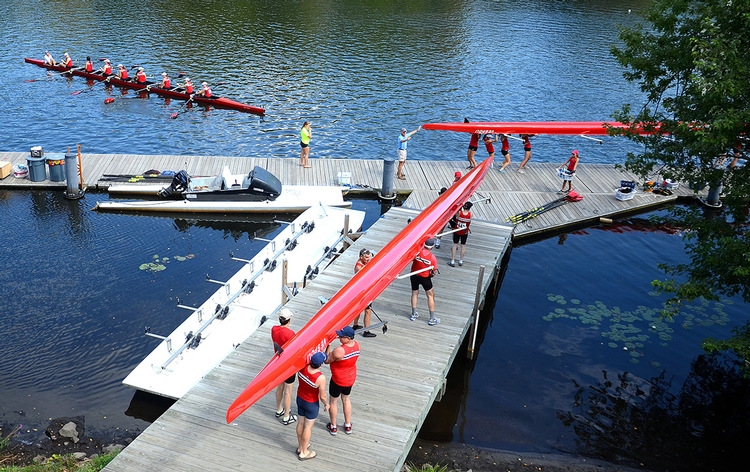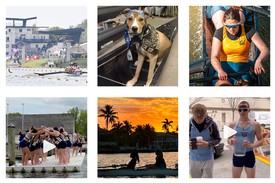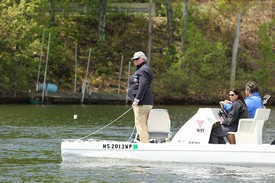
In my first spring season, I walked out on to the dock - a buoyant, removable system of interlocked plastic bubbles - on a beautiful day to grab my water bottle. Suddenly, gravity won, one leg plunged through a broken block in the dock, and water went all the way to my thigh. While amusing for me (and my teammates), I did walk away with a scar and added awareness of safety.
All boathouses and teams will have these stories, and some accidents can be much worse. As we transition into the late spring and summer seasons, with more time on the water and increased use of equipment, it's important to remind yourself and your team that safety is one of the most important ways to have a fun, productive and competitive experience rowing.
In Your Program
"Establish your standards early on," says Kane Larin, Director of Programs & Operations at Community Rowing, Inc. Every coach should be CPR and AED certified, with those certifications kept current. "This ensures you have a better experience for both coaches and participants."
To create the culture of safety, CRI holds summits and contests to engage its community in its commitment, as well as including check-ins in the end-of-program survey. Constant dialogue and feedback with administrators, coaches, and participants is critical for knowing potential problems and solutions.
Safety should be a constant, dynamic part of the program, not just a one-and-done box to check. Always be aware of the condition the equipment is in; a minor problem in one practice can quickly become a major malfunction in another (not unlike the hole in the dock that swallowed me up). Keep a log of these issues and report them to the necessary people as soon as possible.
Make a checklist. USRowing supplies an exemplary Pre-Practice Safety Checklist to work with before your team pushes off the dock. The rowers should be swim test certified, and the coach should have life jackets on and in the launch in case of emergency, as well as standardized kits containing essential items like fire extinguishers and emergency blankets. "If you need it, you have it," says Larin.

SafeSport, a campaign by the US Olympic Committee and in partnership with USRowing, aims to shift the culture of safety in sports to the number one priority instead of just an extension. SafeSport intends to "promote an environment free from bullying, hazing, harassment (including sexual harassment), emotional misconduct, physical misconduct and sexual misconduct (including child sexual abuse)." Make sure you create a safe environment and culture on your team in which rowers and other members of the team feel comfortable raising concerns with you.
On The Water
It's important to keep in mind that there isn't a one-size-fits-all safety plan when it comes to teams and boathouses. Weather patterns and waterways are incredibly different; the Charles River traffic in Boston is quieter than rowing in California's Pacific Ocean or the canals of the middle of the country, where massive stock ships can dwarf a shell and traffic patterns are much more regimented. Furthermore, each waterway will have its own regulations to follow.
Coaches should always be aware of the weather and incoming forecasts, as well as how they translate to water conditions. Watch for high winds and subsequent potential flood conditions, as well as fog. Know which skill levels translate to what ability to handle rough waters, and create a cut-off for wind speeds and practice. Understand how cold weather can affect rowers. The general rule is the 40-50 rule: if the air is below 40 degrees and water below 50, the potential for hypothermia is drastically increased.
Hot weather also requires extra thought. To avoid dehydration, make sure rowers, coaches and coxswains drink water before, during, and after being in the sun. The safest thing to do, however, is to plan practices around the sun, so that the amount of sun exposure is not highest at the highest activity level.
At the beginning of each season, walk your team through the appropriate clothing layering system. In the winter, a wind/waterproof outer layer should complement insulated pieces as well as wicking, quick-drying base layers and hats. Encourage light-colored clothing to reduce effects of the sun in the warmer months (some clothing is UPF-rated, so consider suggesting this to particularly sun-sensitive teammates). Clothing should always be loose enough to be comfortable and nonrestrictive during movement, but tight enough so not to get caught on the seats or other parts of equipment.
Another safety step to consider integrating to your program is developing a code of words or motions to signal potential emergencies in the water, from coach to boats, that is introduced at the beginning of the season. This coupled with standard water-treading and fitness tests is an efficient way to cover your bases.
In the Boathouse
Safety is important even in the boathouse, or on the erg. Proper form and posture should be maintained to mitigate potential for injury while using all equipment, and machines should be weighted to prevent sliding. On the other side of the rowing schedule, times for regattas, those driving should be comfortable with the equipment.
Have a list on hand and displayed prominently in the boathouse of all vital telephone numbers and local emergency services that relate to safety, and ensure everyone that passes through the boathouse and uses the equipment knows where it is. Safety and First Aid equipment should also be easily accessible and always fully stocked.

Where is safety in rowing trending? "There's always innovation and progress to be made when it comes to safety," says Larin. Pilot programs for real-time GPS boat tracking will help pinpoint locations if someone is not back on time, as well as automatically logging boat usage and logistics in order to locate athletes in times of emergency.
Ultimately, integrating safety into your curriculum and administrative calendar keeps it at the forefront of the program. "Watch the videos and do the check-ins, even if they've already seen it or heard it," says Larin. No matter the skill level, you, your rowers and coaches should be prepared for that worst-case scenario.
If you enjoy and rely on row2k, we need your help to be able to keep doing all this. Though row2k sometimes looks like a big, outside-funded operation, it mainly runs on enthusiasm and grit. Help us keep it coming, thank you! Learn more.
Comments | Log in to comment |
There are no Comments yet
| |
- Bont Rowing
- Calm Waters Rowing
- Concept 2
- Craftsbury Sculling
- The Crew Classic
- CrewLAB
- Croker
- Dad Vail Regatta
- Durham Boat Co.
- Empacher
- Faster Masters
- Filippi
- Fluidesign
- h2row.net
- HUDSON
- Live2Row Studios
- Nielsen-Kellerman
- Oak Ridge RA
- Peinert Boat Works
- Pocock Racing Shells
- Race1 USA
- Rockland Rowing Masters Regatta
- RowKraft
- Rubini Jewelers
- Vespoli USA
- WinTech Racing
- Bont Rowing
- Calm Waters Rowing
- Concept 2
- Craftsbury Sculling
- The Crew Classic
- CrewLAB
- Croker
- Dad Vail Regatta
- Durham Boat Co.
- Empacher
- Faster Masters
- Filippi
- Fluidesign
- h2row.net
- HUDSON
- Live2Row Studios
- Nielsen-Kellerman
- Oak Ridge RA
- Peinert Boat Works
- Pocock Racing Shells
- Race1 USA
- Rockland Rowing Masters Regatta
- RowKraft
- Rubini Jewelers
- Vespoli USA
- WinTech Racing
















